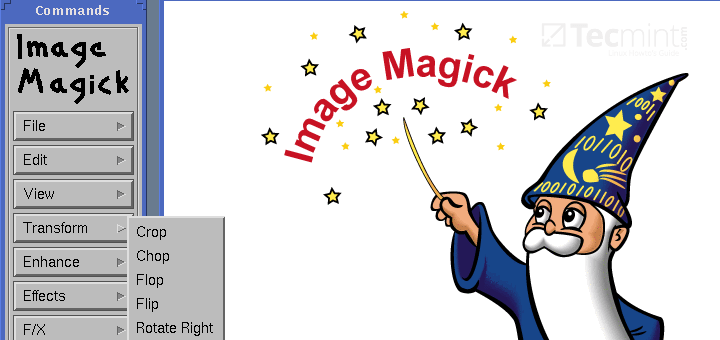
- #FIND IMAGEMAGIC PATH CENTOS HOW TO#
- #FIND IMAGEMAGIC PATH CENTOS MAC OS#
- #FIND IMAGEMAGIC PATH CENTOS INSTALL#
- #FIND IMAGEMAGIC PATH CENTOS UPDATE#
- #FIND IMAGEMAGIC PATH CENTOS SOFTWARE#
~]# php -m | grep imagickĪlternatively, create a file known as ‘ info.php‘ under site root directory. ~]# systemctl restart rviceĬheck imagick PHP extension by executing the following command. ~]# echo extension=imagick.so > /etc/php.ini

Next, add the ‘ imagick.so‘ extension to ‘ /etc/php.ini‘ file. It will prompt you to supply Imagemagick installation prefix and you need to press enter to auto detect. You should add " extension=imagick.so" to php.ini
#FIND IMAGEMAGIC PATH CENTOS INSTALL#
Install ok: channel:///imagick-3.4.1Ĭonfiguration option " php_ini" is not set to php.ini location Installing ' /usr/include/php/ext/imagick/php_imagick_shared.h' Installing ' /usr/lib64/php/modules/imagick.so' Please provide the prefix of Imagemagick installation : Starting to download imagick-3.4.1.tgz (239,829 bytes)
#FIND IMAGEMAGIC PATH CENTOS UPDATE#
WARNING: channel " " has updated its protocols, use " pecl channel-update " to update If you are using 64-bit system, the module directory path should be /usr/lib64/php/modules. This will install the ImageMagick and also imagick PHP extension module ‘ imagick.so‘ under /usr/lib/php/modules directory. Now you need to compile the imagick for PHP extension by executing the following ‘ pecl‘ command. > Processing Dependency: libwmflite-0.2.so.7()(64bit) for package: ImageMagick-6.7.8.9-13.el7_2.x86_64 For CentOS Stream 9 (including src.rpm and debuginfo packages), see CentOS Stream. ~]# yum install ImageMagick ImageMagick-devel ImageMagick-perl -y
#FIND IMAGEMAGIC PATH CENTOS SOFTWARE#
Perl-Data-Dumper.x86_64 0:2.145-3.el7 perl-Test-Harness.noarch 0:3.28-3.el7 perl-Thread-Queue.noarch 0:3.02-2.el7Īfter installing php-pear ,php-devel and gcc packages, install ImageMagick software for Perl and PHP using the following command. Loading mirror speeds from cached hostfile ~]# yum install php-pear php-devel gcc -y Install the required packages to compile imagick PHP extension. Install ImageMagick with Imagick PHP extension for PHP and ImageMagick-perl extension for Perl is explained in this article. ImageMagick includes command line options for generating transparent and animated gif image formats and also features like sharpen, resize, rotate and adding special effects to an image. It can be used for thumbnail and captcha creation. It can read and also write many image files like JPEG, GIF, PNG, TIFF and Photo CD image formats.

ImageMagick is a simple open source software suited for any image manipulation, which is used for editing, converting, creating, displaying image files. ").To Install ImageMagick (Image Manipulation) Tool on RHEL/CentOS and Fedora The original album.html (under _includes) from Using LightGallery in Jekyll without tedious configs is the following: I have a problem connecting this to Bootstrap 5. So that means if I take my jekyll folder to another computer, it might not work? How would they know they need to have imagemagick installed as a prerequisite on their computer?
#FIND IMAGEMAGIC PATH CENTOS MAC OS#
Mac OS X: brew install pkg-config imagemagick Why would this be necessary? So it needs to be installed on my main system, not inside the jekyll installation folder, correct? When I read the rmagick link then, it says, e.g.
#FIND IMAGEMAGIC PATH CENTOS HOW TO#
Which makes me wonder: how can I understand how to install rmagick? Here GitHub - alexivkin/Jekyll-Art-Gallery-Plugin: Art/Photo Gallery plugin for Jekyll there is no real explanation? Hi, I am looking for a nice Jekyll gallery plugin for an image gallery with a ‘next-previous’ button and a download button, with some thumbnails on the main page, which should be auto-resized, hopefully lazyloaded, … which will allow me to understand the installation instructions.īrowsing through many plugins, most of which I don’t understand how to install properly, I sometimes read that GitHub - rmagick/rmagick: Ruby bindings for ImageMagick is to be preferred over image-magick since rmagick is supposedly smaller or takes less time to load.


 0 kommentar(er)
0 kommentar(er)
